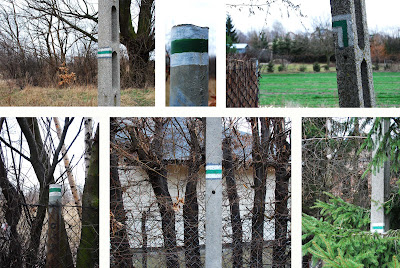
I was in
Łódź (pron.
WOOdzh) yesterday on business; between meetings and my train home I had time to look around. Łódź is Poland's second-largest city (but third-largest agglomeration). Since my first visit here in 1999, the city has made huge strides from a post-industrial wasteland. Unemployment has fallen from over 18% to less than 8%. Huge investments from multinationals such as Procter & Gamble, Bosch-Siemens, Gillette and Indesit have set up factories in the special economic zone. Low-cost flights operate from the city's airport bringing western Europe's labour markets and tourists closer. Europe's largest post-industrial retail development, Manufaktura, has given a boost to services, while ul. Piotrkowska (
above) continues its reign as the world's longest shopping street (five km/three miles, twice as long as London's Oxford Street).

Ul. Piotrkowska is characterised by sumptuous palaces (mostly built in the Secessionist style in the late 19th/early 20th centuries), behind which stood grim textile factories. Many have been renovated, and now house shops, restaurants, clubs and offices.
Here's one of the palaces (
left), standing on the corner of ul. Piotrkowska and ul. Tuwima (named after the poet who wrote
Lokomotywa). Like most of Łódź's industrialists and artists, Julian Tuwim was Jewish - the city had a thriving Jewish community, devastated during the war (300,000 died).
Below: another beautifully-restored palace fronting on ul. Piotrkowska.
 But take a few steps away from the main drag, and the city takes on a different appearance; shabbier, run-down, poorer. The factories that used to churn out textiles, making Łódź Poland's Manchester, have long closed down, leaving brick shells currently put to other use.
But take a few steps away from the main drag, and the city takes on a different appearance; shabbier, run-down, poorer. The factories that used to churn out textiles, making Łódź Poland's Manchester, have long closed down, leaving brick shells currently put to other use.
 Right: The yellow sign to the left of the photo advertises 'cheap clothes', like many shops in the city where you can buy used Western clothing by the kilo. The scores of side-streets and courtyards off Piotrkowska offer interesting sights and shopping experiences.
Right: The yellow sign to the left of the photo advertises 'cheap clothes', like many shops in the city where you can buy used Western clothing by the kilo. The scores of side-streets and courtyards off Piotrkowska offer interesting sights and shopping experiences.
Property prices in Łódź are around half of what they are in Warsaw; I saw flats advertised for 4,300 zlotys - 5,000 /sq.m - so an average sized flat could be had for 40,000 quid. Having said that, prices have doubled in the past four years in GBP terms - but there are still bargains around.
 Buyers with an interest in historic kamienice (tenements) can still find gems worth renovating. The building (left) is fascinating, yet with some sensitive work done to it, can be turned into something priceless. Some replaced tiles, a new balcony, lick of paint, make good...
Buyers with an interest in historic kamienice (tenements) can still find gems worth renovating. The building (left) is fascinating, yet with some sensitive work done to it, can be turned into something priceless. Some replaced tiles, a new balcony, lick of paint, make good...
The style would be called art nouveau in western Europe, but it shows definite tendencies towards Art Deco, though this is a good two decades early. That head at the top foreshadows the famous Wembley Lions.
 Łódź is also internationally famous for its film school and studios. Earlier this year, a UK/Polish/Norwegian production, Peter and the Wolf, won an Oscar for best animated film short. The film is set to Prokofiev's music. And here is that Oscar, on display in Łódź, along with the protagonist and several other characters and elements from the set, all displayed under heavy security in Łódź, where the film was shot (the Se-ma-for studio).
Łódź is also internationally famous for its film school and studios. Earlier this year, a UK/Polish/Norwegian production, Peter and the Wolf, won an Oscar for best animated film short. The film is set to Prokofiev's music. And here is that Oscar, on display in Łódź, along with the protagonist and several other characters and elements from the set, all displayed under heavy security in Łódź, where the film was shot (the Se-ma-for studio).
Close to the main station, Łódź Fabryczna, is the city's Alexander Nevsky Russian Orthodox church, beautifully restored. The colours came up beautifully in the late afternoon sunlight. The building is a reminder of the fact that prior to WWI, Łódź was the westernmost outpost of the Russian Empire. Warsaw had one of these franchises too, much, much bigger, on what is now pl. Piłsudskiego; it was torn down in the 1920s.

 A rare sight in the Jeziorki wetlands - a pair of swans flew in today. How long will they stay? Plenty of ducks, moorhens and black-headed gulls about too. Eddie's friend Wojtek says he saw a pair of herons earlier today. It's all happening bird-wise, spring is beginning to assert itself.
A rare sight in the Jeziorki wetlands - a pair of swans flew in today. How long will they stay? Plenty of ducks, moorhens and black-headed gulls about too. Eddie's friend Wojtek says he saw a pair of herons earlier today. It's all happening bird-wise, spring is beginning to assert itself.

















































